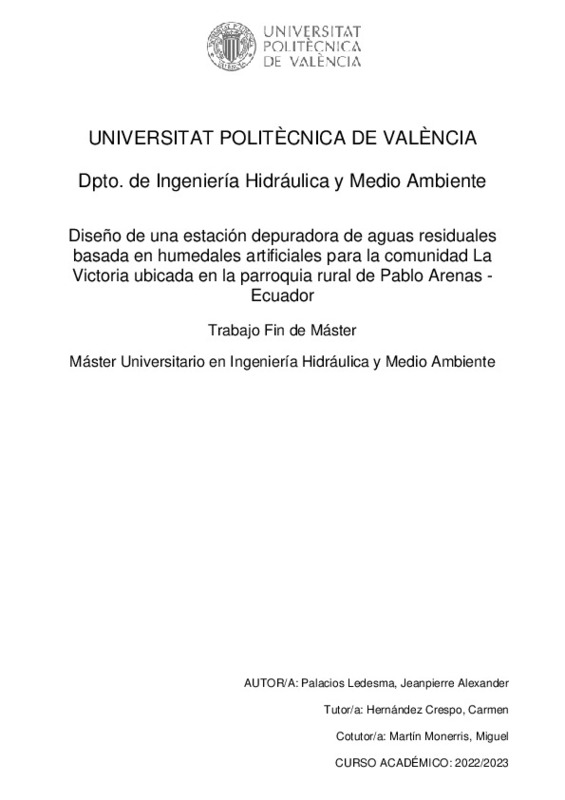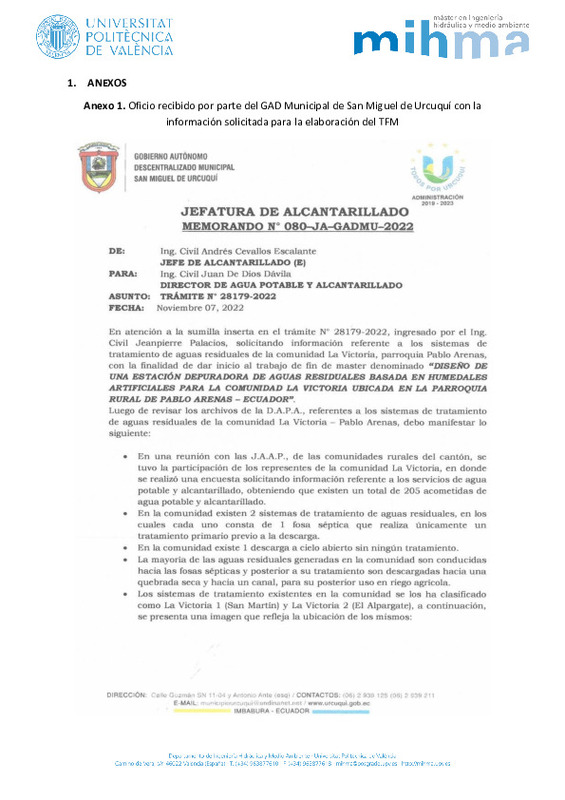|
Resumen:
|
[ES] La República del Ecuador, geográficamente ubicada en la costa oeste de Sudamérica, se
organiza en 24 provincias, cada una fraccionada en cantones que a su vez se subdividen en
pequeñas poblaciones conocidas como ...[+]
[ES] La República del Ecuador, geográficamente ubicada en la costa oeste de Sudamérica, se
organiza en 24 provincias, cada una fraccionada en cantones que a su vez se subdividen en
pequeñas poblaciones conocidas como parroquias urbanas y parroquias rurales.
Pablo Arenas, parroquia rural correspondiente al Cantón San Miguel de Urcuquí, permite
evidenciar la grave problemática que aqueja a estas zonas del país en cuanto a la escasa
cobertura de servicios básicos, particularmente al sistema deficiente de alcantarillado y
tratamiento de aguas residuales que trae consigo varios problemas ambientales
identificados a través del mal olor, proliferación de insectos y aparición de roedores que
no sólo arriesgan la salud de sus habitantes sino que vulneran la integridad física de niños y
adultos mayores.
Las afectaciones ambientales se extienden a zonas como la comunidad “La Victoria”,
perteneciente a la parroquia rural de Pablo Arenas, donde habitan alrededor de 205 familias
que en su mayoría son afrodescendientes y de escasos recursos económicos, quienes por
falta de oportunidades a muy temprana edad empiezan a trabajar en la limpieza de la caña
de azúcar conocida como zafra.
El agua residual generada en esta comunidad se descarga en 3 puntos, dos de ellos a un
sistema de tratamiento conformado por una sola fosa séptica y el último descarga
directamente sin ningún tratamiento, a lo cual se le conoce como “descarga a cielo abierto”.
Cabe indicar que las fosas sépticas en las cuales se trata el agua residual están colapsadas y
obsoletas, es decir, el agua residual prácticamente es descargada sin tratamiento alguno a
fuentes de agua dulce que luego son utilizadas en actividades agropecuarias aguas abajo.
Por la razón antes expuesta, las autoridades locales han acudido a instancias
gubernamentales a fin de solicitar se canalicen lo antes posible los recursos económicos
para la construcción de un nuevo sistema de alcantarillado con su respectiva EDAR pero no
han obtenido respuestas favorables, con lo que sigue aumentando la contaminación
ambiental y con ello los evidentes problemas de salud de la población.
Se ha determinado que el tratamiento del agua residual mediante humedales artificiales es
considerado un complemento adecuado del tratamiento convencional, además de ser un
sistema económico por su sencilla construcción, operación y mantenimiento, presenta una
gran integración visual, paisajística y amigable con el medio ambiente. Por otra parte, cabe
indicar que estos sistemas generan importantes espacios naturales protegidos con hábitat
para la fauna, lo que conlleva a que en la actualidad tengan una gran aceptación social.
Por lo antes expuesto se ha realizado el diseño de una estación depuradora de aguas
residuales basada en humedales artificiales la cual cumple con los requerimientos de la
comunidad y con ello se pueda tratar toda el agua residual generada garantizando el
cumplimiento de las normativas ambientales vigentes y a su vez aprovechando el efluente
de la EDAR para riego en las actividades de agricultura que desarrollan los habitantes.
La ubicación propuesta de la EDAR diseñada tiene como coordenadas N: 10055882.49, E:
816856.88 y se encuentra a una altitud de 1751 m.s.n.m., lo que permitirá que toda el agua
residual llegue a la EDAR por gravedad y con ello que su operación sea sencilla y económica
para que así no se tengan que incurrir en gastos considerables de operación y/o
mantenimiento.
La EDAR consta de varias etapas de tratamiento como son: pretratamiento (aliviadero, canal
de desbaste, rejas gruesas, rejas finas y desarenador de flujo horizontal), tratamiento
primario (dos tanques imhoff en paralelo), tratamiento secundario en el cual se consideró
3 alternativas (humedal artificial de flujo subsuperficial horizontal, vertical y vertical
“sistema francés”, este último no requiere de un tratamiento primario previo) y finalmente
un tratamiento terciario (humedal artificial de flujo superficial horizontal) que cumple con
la función de renaturalizar y desinfectar el agua de una manera natural y económica.
El estudio de las alternativas de tratamiento secundario descritas anteriormente
permitieron determinar que la alternativa 1 (humedal artificial de flujo subsuperficial
horizontal) es la que mejor se ajusta y la que más conveniente resulta aplicar en la
comunidad ya que fue la alternativa que mejor cumple con todos los factores y criterios
analizados para llegar a la conclusión y resultado final, criterios que posteriormente en este
trabajo se los especificará con mayor detalle.
Finalmente, al tratarse de un proyecto que contempla el diseño de una EDAR, considerado
como un servicio básico indispensable, se buscará la manera de presentarlo a las
autoridades locales de la zona y con ello intentar llevar a cabo su construcción y así
beneficiar a todos sus habitantes.
[-]
[EN] The Republic of Ecuador, geographically located on the west coast of South America, is
organized into 24 provinces, each divided into cantons, which in turn are subdivided into
small towns known as urban parishes ...[+]
[EN] The Republic of Ecuador, geographically located on the west coast of South America, is
organized into 24 provinces, each divided into cantons, which in turn are subdivided into
small towns known as urban parishes and rural parishes.
Pablo Arenas, a rural parish corresponding to the San Miguel de Urcuquí Canton, makes it
possible to demonstrate the serious problems that afflict these areas of the country in terms
of the low coverage of basic services, particularly the deficient sewage system and
wastewater treatment that brings with it several environmental problems identified
through bad smell, proliferation of insects and appearance of rodents that not only risk the
health of its inhabitants but also violate the physical integrity of children and the elderly.
The environmental impacts extend to areas such as the "La Victoria" community, belonging
to the rural parish of Pablo Arenas, where around 205 families live, the majority of whom
are Afro-descendants and with limited economic resources, who due to a lack of
opportunities at a very early age age they begin to work cleaning the sugar cane known as
zafra.
The wastewater generated in this community is discharged at 3 points, two of them to a
treatment system made up of a single septic tank and the last one discharges directly
without any treatment, which is known as "open air discharge". It should be noted that the
septic tanks in which the wastewater is treated are collapsed and obsolete, that is, the
wastewater is practically discharged without any treatment to freshwater sources that are
later used in agricultural activities downstream.
For the aforementioned reason, the local authorities have turned to government agencies
in order to request that the economic resources be channeled as soon as possible for the
construction of a new sewerage system with its respective WWTP, but they have not obtained favorable responses, with what follows increasing environmental pollution and
with it the evident health problems of the population.
It has been determined that the treatment of wastewater through artificial wetlands is
considered an adequate complement to conventional treatment, in addition to being an
economical system due to its simple construction, operation and maintenance, it presents
a great visual, landscape and friendly integration with the environment. On the other hand,
it should be noted that these systems generate important protected natural spaces with
habitat for fauna, which means that they currently have great social acceptance.
Due to the above, the design of a wastewater treatment plant based on artificial wetlands
has been carried out, which meets the requirements of the community and with this, all the
wastewater generated can be treated, guaranteeing compliance with current
environmental regulations and at its time taking advantage of the effluent from the WWTP
for irrigation in the agricultural activities carried out by the inhabitants.
The proposed location of the designed WWTP has the coordinates N: 10055882.49, E:
816856.88 and is located at an altitude of 1751 meters above sea level, which will allow all
the residual water to reach the WWTP by gravity and thus make its operation simple and
economical so that considerable operating and/or maintenance expenses do not have to be
incurred.
The WWTP consists of several treatment stages such as: pretreatment (spillway, roughing
channel, coarse grates, fine grates and horizontal flow grit), primary treatment (two imhoff
tanks in parallel), secondary treatment in which 3 alternatives were considered (horizontal,
vertical and vertical "French system" subsurface flow artificial wetland, the latter does not
require prior primary treatment) and finally a tertiary treatment (horizontal superficial flow
artificial wetland) that fulfills the function of renaturalizing and disinfecting the water in a
natural and economical way.
The study of the secondary treatment alternatives described above made it possible to
determine that alternative 1 (horizontal subsurface flow artificial wetland) is the one that
best fits and the one that is most convenient to apply in the community since it was the
alternative that best complies with all the factors and criteria analyzed to reach the
conclusion and final result, criteria that will be specified in greater detail later in this work.
Finally, as it is a project that contemplates the design of a WWTP, considered as an essential
basic service, a way will be sought to present it to the local authorities of the area and with
this try to carry out its construction and thus benefit all its population.
[-]
|








